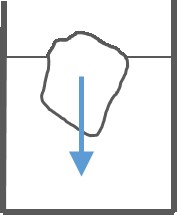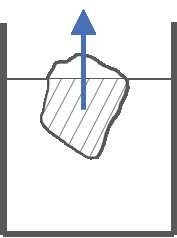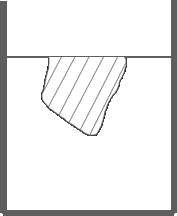Link Melting of sea ice Sea level rise
Physical phenomenon
When sea ice floats, it is subjected to two forces:
- Gravity, equal to the weight of the ice block (Figure 1) :
- Archimedes' thrust, equal to the weight of the volume of water displaced by the ice block (Figure 2).
Since the ice block is in equilibrium, these two forces compensate each other. The weight of the ice block is therefore equal to the weight of the volume of water displaced. The same weight means the same amount of matter. Therefore, once melted, it will occupy exactly the volume that was below its waterline before it melted. It will therefore not contribute to raising the water level (Figure 3).
This works for large ice blocks in the sea and also for ice cubes in a drink, as long as the ice is floating and is not supported by something solid.
Limits
A seasoned player might point out that this only works if the water in the ice pack and the water in which it floats have the same density. As the pack ice is fresh water and what it floats in is not, there can be a slight change in the water level, but this is very negligible.
Popularisation
Trivia
This reasoning only works when the ice cubes do not touch the bottom, and in a glass of whisky, they touch the bottom, so one should not translate Ricard by whisky. Either the facilitator can take the opportunity to introduce the players to the important part of French culture that is Ricard, or just discuss ice cubes in a glass of coke.


